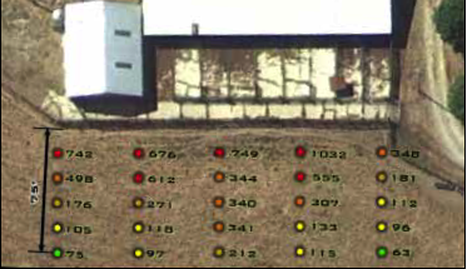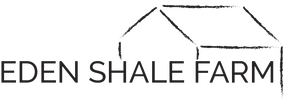An enhanced vegetative strip (EVS) is a best management practice that can be installed to protect surface waters from pollution produced by animal production facilities. If properly managed, enhanced vegetative strips can be used to trap, treat, and absorb pollutants, which can be removed from the designated area by harvesting or grazing.
An enhanced vegetative strip is an area of grass or other permanent vegetation that is maintained to remove sediment, organic material, nutrients, pesticides, and other contaminants from runoff in order to protect water quality. These strips slow the velocity of water, allowing particles to settle out and infiltration to increase. Enhanced vegetative strips also have the ability to produce high per-unit yields from an area that is essentially irrigated with the runoff received from impervious areas—water and nutrients that would otherwise be wasted.
The concrete pad at the bull barn drains runoff containing nutrients and other pollutants into the adjacent pasture. Soil samples were taken from that adjacent pasture. Soil samples from the area receiving this drainage were analyzed for soil test phosphorus (STP), with the results shown in relation to the distance from the facility. These results show a high concentration of phosphorus near the facility that decreases as the distance from the facility increases. Although only phosphorus concentrations are shown, other pollutants, such as pathogens and nitrogen, could also be present.
An enhanced vegetative strip is an area of grass or other permanent vegetation that is maintained to remove sediment, organic material, nutrients, pesticides, and other contaminants from runoff in order to protect water quality. These strips slow the velocity of water, allowing particles to settle out and infiltration to increase. Enhanced vegetative strips also have the ability to produce high per-unit yields from an area that is essentially irrigated with the runoff received from impervious areas—water and nutrients that would otherwise be wasted.
The concrete pad at the bull barn drains runoff containing nutrients and other pollutants into the adjacent pasture. Soil samples were taken from that adjacent pasture. Soil samples from the area receiving this drainage were analyzed for soil test phosphorus (STP), with the results shown in relation to the distance from the facility. These results show a high concentration of phosphorus near the facility that decreases as the distance from the facility increases. Although only phosphorus concentrations are shown, other pollutants, such as pathogens and nitrogen, could also be present.
Nutrients, pathogens, and sediment moving off-site from the livestock facility could be trapped, treated, and removed by installing enhanced vegetative strips along the edge of the concrete pad and into the adjacent pasture. If implemented correctly, the width of the strip should coincide with the width of the facility (or the drainage area), and the strip should extend far enough to capture pollutants from the runoff until phosphorus levels have decreased to natural levels.
Design Specifications
Enhanced vegetative strips should be located immediately downhill from the production area and are most effective in areas that have a grade of less than 5%. Using enhanced vegetative strips on slopes greater than 15% is not recommended. The width of the enhanced vegetative strip, from top of the hill to the bottom, should increase as the slope increases.
Enhanced vegetative strips should be located immediately downhill from the production area and are most effective in areas that have a grade of less than 5%. Using enhanced vegetative strips on slopes greater than 15% is not recommended. The width of the enhanced vegetative strip, from top of the hill to the bottom, should increase as the slope increases.
When there is an environmentally sensitive area below the production area, the NRCS recommends the establishment of an enhanced vegetative strip with a minimum width of 60 feet. Justification for a 60-foot buffer width is depicted in the image below, in which the phosphorus levels begin to drop off sharply approximately 60 feet from the facility.
Vegetation Establishment
The type of vegetation used in the enhanced vegetative strip is one of the most crucial elements in creating an effective barrier between a pollutant source and water resources. Some species of vegetation are more beneficial than others in certain situations, so it is important to determine which type of vegetation is most beneficial to you and the environment. Since it is important to remove the vegetation in order to remove excess nutrients, the vegetation should serve a purpose after harvesting. Depending on the intended post-harvest use and the season in which filtering needs to be accomplished, several different types of vegetation could be used.
The type of vegetation should be chosen based on seasonal management differences. For example, if the facility producing runoff is being used for backgrounding calves during the fall and winter season, cool-season vegetation should be chosen, because it will be actively growing during the confinement period, when pollutants are released. Warm-season vegetation should be selected for the summer months to help facilitate additional removal of nutrients. For the bull barn facility, a blend of orchardgrass and timothy was selected as the warm-season grass, and a perennial rye was interseeded to provide a cool-season grass in the same area. The strip was established in the fall by first spraying the area with 2,4-D herbicide to remove broadleaf weeds and then interseeding the mix into a stand of tall fescue.
Management
Managing an enhanced vegetative strip includes harvesting the vegetation in some way in order to remove excess nutrients from the soil. Essentially, there are two types of enhanced vegetative strips: those that are accessible by livestock and those that are not. Other maintenance practices, aside from grazing and harvesting, that ensure an effective enhanced vegetative strip include proper fertilization and weed control.
- Grazing: Flash grazing gives cattle limited access to the enhanced vegetative strip and is accomplished by fencing off the EVS, allowing cattle stocked at a relatively high density to graze the area for a period of two to four days at a time with approximately 30 days between grazing periods.
- Fencing: When an enhanced vegetative strip is open to periodic grazing, a temporary electric fence should be used to simplify the process of opening and closing the strip area.
- Harvesting: If the strip is not accessible to livestock, it should be cut for hay.
Click the button below to read the full publication on enhanced vegetative strips.
CONTACT US |
EMAIL SIGN UP |
|
Eden Shale Farm
245 Eden Shale Rd. Office: (859) 278-0899 Owenton, KY 40359 Fax: (859) 260-2060 © 2021 Kentucky Beef Network, LLC.. All rights reserved.
|
Receive our blog updates
|




